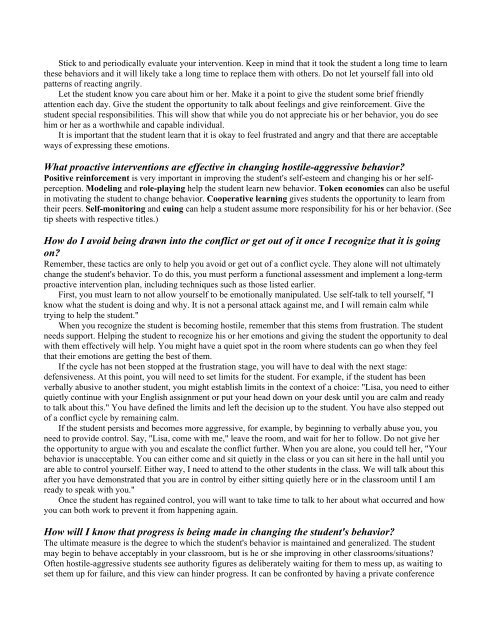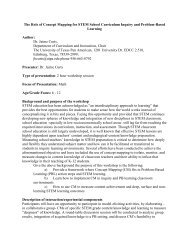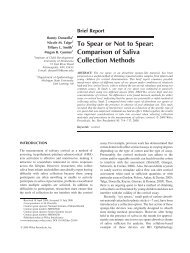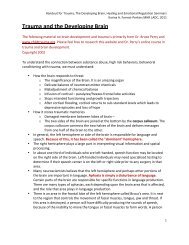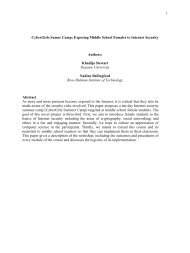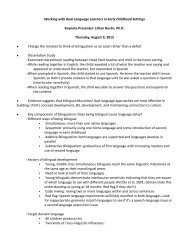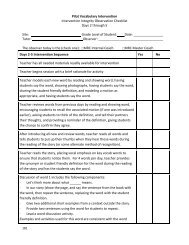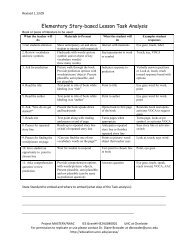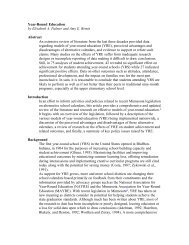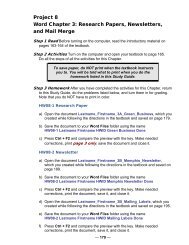Introduction to Positive Ways of Intervening with Challenging Behavior
Introduction to Positive Ways of Intervening with Challenging Behavior
Introduction to Positive Ways of Intervening with Challenging Behavior
You also want an ePaper? Increase the reach of your titles
YUMPU automatically turns print PDFs into web optimized ePapers that Google loves.
Stick <strong>to</strong> and periodically evaluate your intervention. Keep in mind that it <strong>to</strong>ok the student a long time <strong>to</strong> learn<br />
these behaviors and it will likely take a long time <strong>to</strong> replace them <strong>with</strong> others. Do not let yourself fall in<strong>to</strong> old<br />
patterns <strong>of</strong> reacting angrily.<br />
Let the student know you care about him or her. Make it a point <strong>to</strong> give the student some brief friendly<br />
attention each day. Give the student the opportunity <strong>to</strong> talk about feelings and give reinforcement. Give the<br />
student special responsibilities. This will show that while you do not appreciate his or her behavior, you do see<br />
him or her as a worthwhile and capable individual.<br />
It is important that the student learn that it is okay <strong>to</strong> feel frustrated and angry and that there are acceptable<br />
ways <strong>of</strong> expressing these emotions.<br />
What proactive interventions are effective in changing hostile-aggressive behavior?<br />
<strong>Positive</strong> reinforcement is very important in improving the student's self-esteem and changing his or her selfperception.<br />
Modeling and role-playing help the student learn new behavior. Token economies can also be useful<br />
in motivating the student <strong>to</strong> change behavior. Cooperative learning gives students the opportunity <strong>to</strong> learn from<br />
their peers. Self-moni<strong>to</strong>ring and cuing can help a student assume more responsibility for his or her behavior. (See<br />
tip sheets <strong>with</strong> respective titles.)<br />
How do I avoid being drawn in<strong>to</strong> the conflict or get out <strong>of</strong> it once I recognize that it is going<br />
on?<br />
Remember, these tactics are only <strong>to</strong> help you avoid or get out <strong>of</strong> a conflict cycle. They alone will not ultimately<br />
change the student's behavior. To do this, you must perform a functional assessment and implement a long-term<br />
proactive intervention plan, including techniques such as those listed earlier.<br />
First, you must learn <strong>to</strong> not allow yourself <strong>to</strong> be emotionally manipulated. Use self-talk <strong>to</strong> tell yourself, "I<br />
know what the student is doing and why. It is not a personal attack against me, and I will remain calm while<br />
trying <strong>to</strong> help the student."<br />
When you recognize the student is becoming hostile, remember that this stems from frustration. The student<br />
needs support. Helping the student <strong>to</strong> recognize his or her emotions and giving the student the opportunity <strong>to</strong> deal<br />
<strong>with</strong> them effectively will help. You might have a quiet spot in the room where students can go when they feel<br />
that their emotions are getting the best <strong>of</strong> them.<br />
If the cycle has not been s<strong>to</strong>pped at the frustration stage, you will have <strong>to</strong> deal <strong>with</strong> the next stage:<br />
defensiveness. At this point, you will need <strong>to</strong> set limits for the student. For example, if the student has been<br />
verbally abusive <strong>to</strong> another student, you might establish limits in the context <strong>of</strong> a choice: "Lisa, you need <strong>to</strong> either<br />
quietly continue <strong>with</strong> your English assignment or put your head down on your desk until you are calm and ready<br />
<strong>to</strong> talk about this." You have defined the limits and left the decision up <strong>to</strong> the student. You have also stepped out<br />
<strong>of</strong> a conflict cycle by remaining calm.<br />
If the student persists and becomes more aggressive, for example, by beginning <strong>to</strong> verbally abuse you, you<br />
need <strong>to</strong> provide control. Say, "Lisa, come <strong>with</strong> me," leave the room, and wait for her <strong>to</strong> follow. Do not give her<br />
the opportunity <strong>to</strong> argue <strong>with</strong> you and escalate the conflict further. When you are alone, you could tell her, "Your<br />
behavior is unacceptable. You can either come and sit quietly in the class or you can sit here in the hall until you<br />
are able <strong>to</strong> control yourself. Either way, I need <strong>to</strong> attend <strong>to</strong> the other students in the class. We will talk about this<br />
after you have demonstrated that you are in control by either sitting quietly here or in the classroom until I am<br />
ready <strong>to</strong> speak <strong>with</strong> you."<br />
Once the student has regained control, you will want <strong>to</strong> take time <strong>to</strong> talk <strong>to</strong> her about what occurred and how<br />
you can both work <strong>to</strong> prevent it from happening again.<br />
How will I know that progress is being made in changing the student's behavior?<br />
The ultimate measure is the degree <strong>to</strong> which the student's behavior is maintained and generalized. The student<br />
may begin <strong>to</strong> behave acceptably in your classroom, but is he or she improving in other classrooms/situations?<br />
Often hostile-aggressive students see authority figures as deliberately waiting for them <strong>to</strong> mess up, as waiting <strong>to</strong><br />
set them up for failure, and this view can hinder progress. It can be confronted by having a private conference


